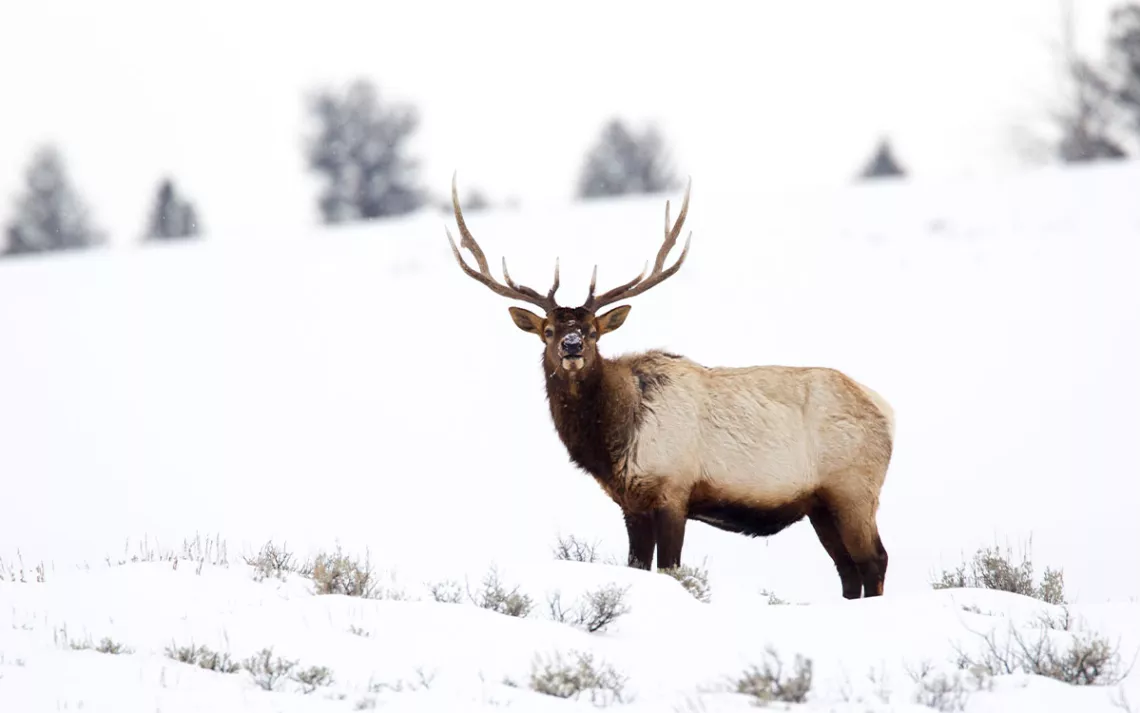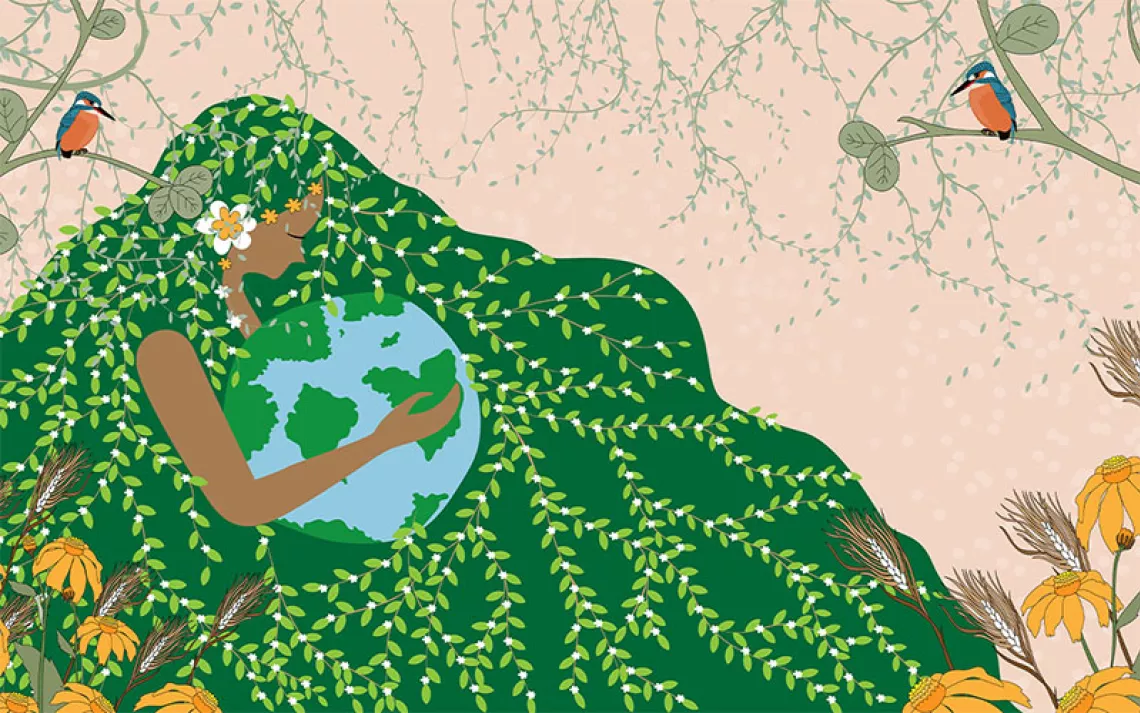An Elk Kind of Holiday
Our kids were coming for Christmas, but it was the elk who stayed for dinner

They first appeared at dawn and dusk: one elk after another walking single-file through the snow. Winter came early to our home in rural Idaho last year, dropping three feet of powder in the timbered canyon behind our house and coating the mountains above it bright white. We’d spent weeks prepping for the holidays: stocking the freezer, readying the guest room for our grandson’s first Christmas, putting up lights and a tree.
But it was the arrival of unexpected guests, a vast herd of elk that trekked down from the high canyon and fanned out beneath the fir trees fronting our cabin that made the season strangely magical.
I’ve pursued awe-inducing experiences all my life—spending weeks wilderness sailing in hopes of seeing a rare white spirit bear; heading solo to Antarctica and Rwanda and the Amazon in search of wild landscapes and habitats. But since the pandemic, I realized I’ve traded a diet of distant adventures for new ones closer to home: One son got married; the other became a dad. I wasn’t yet sure how I felt about becoming a grandparent.
Would a love for the natural world translate to love for a tiny human?
*
My son and daughter-in-law arrived from New York with our grandson on a day when the high in central Idaho was 9°F. It was too cold to bundle up a nine-month-old and go out, so we all stayed in—snacking on chocolate-chip cookies I’d been stockpiling like a squirrel.
The next morning, my son and grandson were up early. As I crossed to the kitchen in the dark, a shadowy form caught my eye. Then another. Peering through our living room window, I could just make out a shaggy, antlered creature standing at the base of a conifer. I could see three more bedded down in the snow and a fourth, neck stretched, stripping frozen fir needles off a branch. Would there even be anything left to eat out there, I wondered?
As dawn broke and dim light spread across the meadow, a long line of tawny brown beings moved slowly through knee-deep snow toward the fir trees, aspen, and willow fronting our cabin. My son and I grabbed the baby and our coffee cups and stood, mesmerized, as elk kept coming. A herd of 50 or 60 drifted in like smoke: cows with copper-colored coats and white rumps, calves with spindly legs, young bucks with spike horns, and finally, standing apart, a magnificent bull with huge branched antlers.
It’s odd how we’re often taught to think—especially around the holidays—what family is and what form our traditions should take. Parents. Siblings. Presents. But a herd of Rocky Mountain elk? Idaho’s premiere big-game animal? Were they now going to be a family tradition too?
The temperatures stayed low, and outside the snow kept sifting downward. It was like living inside a snow globe, with flakes blanketing the ground; in the middle, a circle of elk bedded down for the holidays.
Winter is tough on wild animals. Elk have existed for thousands of years throughout the western states, migrating between summer ranges in the high country and winter ranges at lower elevations. Living on the edge of BLM and National Forest Service land, we’re used to encounters with the wild. Packs of coyotes howl outside our bedroom window some nights, mountain lions prowl the neighborhood, and one memorable winter, my dog, husband, sons, and I were false charged in deep snow by a bull moose.
But the elk seemed calm, the essence of endurance.
I called our local BLM office to ask how we could be most respectful of our unexpected guests. “The thing that’s tricky now is that some elk traditionally migrate from higher country to lower country during winter,” John Kurtz, BLM’s Shoshone outdoor recreation planner told me. “They’ve adapted to minimize expending stored fat reserves in order to survive a harsh season and heavy snowpack like this when there’s not much nutritional value in the forage. But if they become distressed by dogs, vehicles, or people—and there are definitely more of us—it really wears down their energy.”
If you are out with your dogs and encounter elk or deer or moose in winter, Kurtz continued, it’s essential to be able to control your pets. For most people, that means keeping dogs leashed, although it’s not always easy. Elk see dogs as a predator—a wolf or coyote—and deep snow gives the advantage to the dog, especially when a hard crust forms on top. The elk is left floundering while a dog can run over the surface.
*
After speaking with Kurtz, we leashed our dogs and tried to walk them in a wide arc around the herd settled in the snow meadow each day. If our spaniels paid too much attention to the elk, we’d distract the dogs with treats. The elk returned every morning and afternoon that week, making the pilgrimage twice a day, sometimes leaping one by one over a split-rail pasture fence, which made me ache for them given the effort it required in such deep snow.
I’d hold my grandson and we’d stand at the window watching. Sometimes my husband would join us, as well as our dogs. I noticed our little grandson really looked at things. Even with two dogs barking madly (which the elk didn’t seem to hear through the glass), the nine-month-old stayed calm. His big eyes seemed to take in everything.
The snow grew deeper, and then one day the herd suddenly stopped coming. I prayed the animals had moved on, maybe to a warmer spot down valley with more bark, twigs, and shrubs. With the start of the new year, our kids and grandson returned to New York. The house grew still.
I watched for the elk every morning and also each evening as the snow kept falling but never saw them again. But what I did see was this: My role as a new elder could be to pay attention. To learn from my grandson—a watcher, as he hopefully might learn to revere the world and its wonders from me.
 The Magazine of The Sierra Club
The Magazine of The Sierra Club



